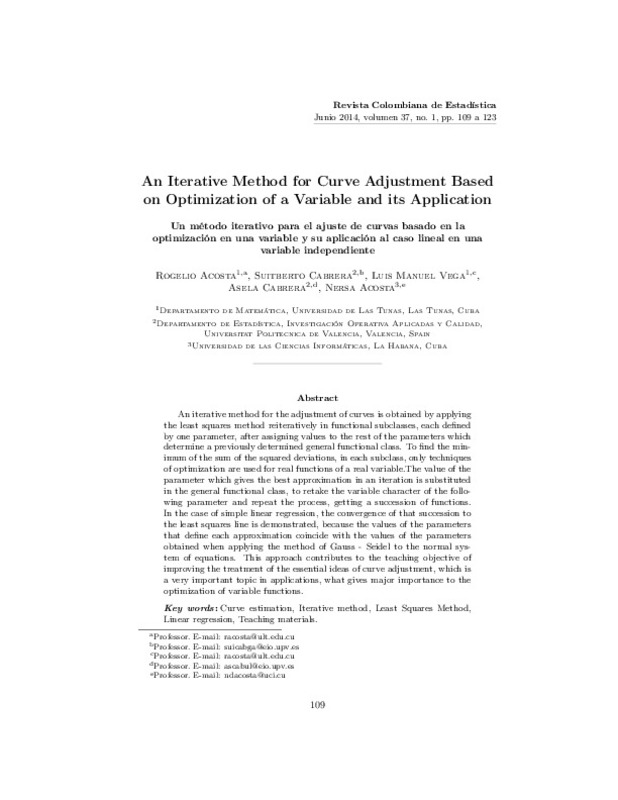JavaScript is disabled for your browser. Some features of this site may not work without it.
Buscar en RiuNet
Listar
Mi cuenta
Estadísticas
Ayuda RiuNet
Admin. UPV
An Iterative Method for Curve Adjustment Based on Optimization of a Variable and its Application
Mostrar el registro sencillo del ítem
Ficheros en el ítem
| dc.contributor.author | Acosta, Rogelio
|
es_ES |
| dc.contributor.author | Cabrera García, Suitberto
|
es_ES |
| dc.contributor.author | Vega, Luis Manuel
|
es_ES |
| dc.contributor.author | Cabrera, Asela
|
es_ES |
| dc.contributor.author | Acosta, Nersa
|
es_ES |
| dc.date.accessioned | 2018-11-21T21:05:44Z | |
| dc.date.available | 2018-11-21T21:05:44Z | |
| dc.date.issued | 2014 | es_ES |
| dc.identifier.issn | 0120-1751 | es_ES |
| dc.identifier.uri | http://hdl.handle.net/10251/112966 | |
| dc.description.abstract | [EN] An iterative method for the adjustment of curves is obtained by applying the least squares method reiteratively in functional subclasses, each defined by one parameter, after assigning values to the rest of the parameters which determine a previously determined general functional class. To find the minimum of the sum of the squared deviations, in each subclass, only techniques of optimization are used for real functions of a real variable.The value of the parameter which gives the best approximation in an iteration is substituted in the general functional class, to retake the variable character of the following parameter and repeat the process, getting a succession of functions. In the case of simple linear regression, the convergence of that succession to the least squares line is demonstrated, because the values of the parameters that define each approximation coincide with the values of the parameters obtained when applying the method of Gauss - Seidel to the normal system of equations. This approach contributes to the teaching objective of improving the treatment of the essential ideas of curve adjustment, which is a very important topic in applications, what gives major importance to the optimization of variable functions. | es_ES |
| dc.description.abstract | [ES] Se obtiene un método iterativo para el ajuste de curvas al aplicar reiteradamente el método de los mínimos cuadrados en subclases funcionales, cada una definida por un parámetro, luego de asignar valores a los restantes parámetros que determinan una clase funcional general, seleccionada previamente. Para hallar el mínimo de la suma de las desviaciones cuadráticas, en cada subclase, solo se utilizan técnicas de optimización para funciones reales de una variable real. El valor del parámetro, que proporciona la mejor aproximación en una iteración, se sustituye en la clase funcional general, para retomar el carácter variable del siguiente parámetro y repetir el proceso, obteniéndose una sucesión de funciones. En el caso de la regresión lineal simple se demuestra la convergencia de esa sucesión a la recta mínimo cuadrática, pues coinciden los valores de los parámetros que definen cada aproximación con los que se obtienen al aplicar el método de Gauss - Seidel al sistema normal de ecuaciones. Este enfoque contribuye al objetivo docente de adelantar el tratamiento de las ideas esenciales del ajuste de curvas, temática muy importante en las aplicaciones, lo que le confiere mayor significación a la optimización de funciones de una variable. | es_ES |
| dc.description.sponsorship | The authors acknowledge the financial support of AECID (Spain) under Project No A2/039476/11 - “Institutional Strengthening in the Teaching of Subjects of Statistics, Operative Investigation, Liability and Quality, and Scientific Application in Topics of Regional Interest”. | |
| dc.language | Inglés | es_ES |
| dc.publisher | Universidad Nacional de Colombia | es_ES |
| dc.relation.ispartof | Revista Colombiana de Estadística | es_ES |
| dc.rights | Reconocimiento - No comercial - Sin obra derivada (by-nc-nd) | es_ES |
| dc.subject | Curve estimation | es_ES |
| dc.subject | Iterative method | es_ES |
| dc.subject | Least Squares Method | es_ES |
| dc.subject | Linear regression | es_ES |
| dc.subject | Teaching materials | es_ES |
| dc.subject.classification | ESTADISTICA E INVESTIGACION OPERATIVA | es_ES |
| dc.title | An Iterative Method for Curve Adjustment Based on Optimization of a Variable and its Application | es_ES |
| dc.title.alternative | Un método iterativo para el ajuste de curvas basado en la optimización en una variable y su aplicación al caso lineal en una variable independiente | es_ES |
| dc.type | Artículo | es_ES |
| dc.identifier.doi | 10.15446/rce.v37n1.44361 | es_ES |
| dc.relation.projectID | info:eu-repo/grantAgreement/MAEC//A2%2F039476%2F11/ES/FORTALECIMIENTO INSTITUCIONAL EN LA ENSEÑANZA DE LAS ASIGNATURAS DE ESTADISTICA, INVESTIGACION OPERATIVA, FIABILIDAD Y CALIDAD Y APLICACIÓN CIENTIFICA EN TEMAS DE INTERES REGIONAL/ | es_ES |
| dc.rights.accessRights | Abierto | es_ES |
| dc.contributor.affiliation | Universitat Politècnica de València. Departamento de Estadística e Investigación Operativa Aplicadas y Calidad - Departament d'Estadística i Investigació Operativa Aplicades i Qualitat | es_ES |
| dc.description.bibliographicCitation | Acosta, R.; Cabrera García, S.; Vega, LM.; Cabrera, A.; Acosta, N. (2014). An Iterative Method for Curve Adjustment Based on Optimization of a Variable and its Application. Revista Colombiana de Estadística. 37(1):111-125. https://doi.org/10.15446/rce.v37n1.44361 | es_ES |
| dc.description.accrualMethod | S | es_ES |
| dc.relation.publisherversion | https://doi.org/10.15446/rce.v37n1.44361 | es_ES |
| dc.description.upvformatpinicio | 111 | es_ES |
| dc.description.upvformatpfin | 125 | es_ES |
| dc.type.version | info:eu-repo/semantics/publishedVersion | es_ES |
| dc.description.volume | 37 | es_ES |
| dc.description.issue | 1 | es_ES |
| dc.relation.pasarela | S\276810 | es_ES |
| dc.contributor.funder | Agencia Española de Cooperación Internacional para el Desarrollo | es_ES |
| dc.contributor.funder | Ministerio de Asuntos Exteriores y Cooperación | es_ES |








